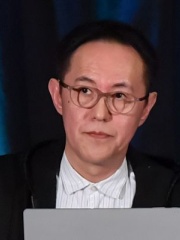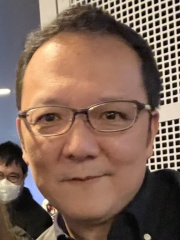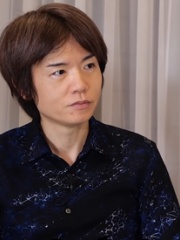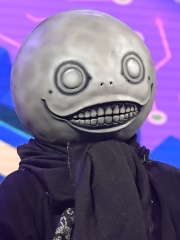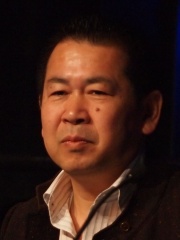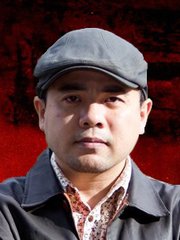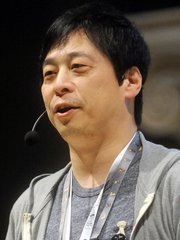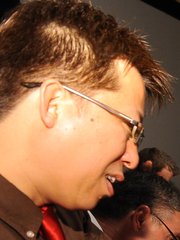
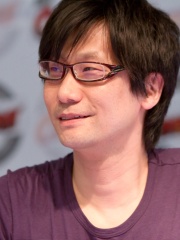
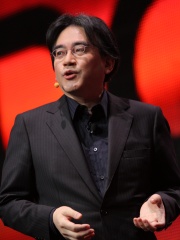
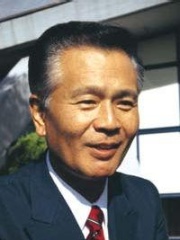

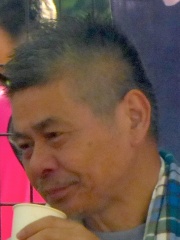
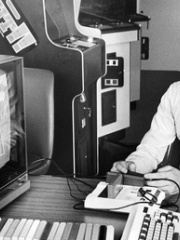
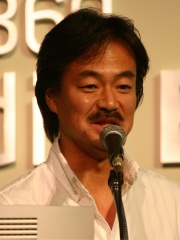
The Most Famous
GAME DESIGNERS from Japan
This page contains a list of the greatest Japanese Game Designers. The pantheon dataset contains 77 Game Designers, 31 of which were born in Japan. This makes Japan the birth place of the 2nd most number of Game Designers.
Top 10
The following people are considered by Pantheon to be the top 10 most legendary Japanese Game Designers of all time. This list of famous Japanese Game Designers is sorted by HPI (Historical Popularity Index), a metric that aggregates information on a biography's online popularity. Visit the rankings page to view the entire list of Japanese Game Designers.

1. Shigeru Miyamoto (b. 1952)
With an HPI of 69.47, Shigeru Miyamoto is the most famous Japanese Game Designer. His biography has been translated into 58 different languages on wikipedia.
Shigeru Miyamoto (Japanese: 宮本 茂, Hepburn: Miyamoto Shigeru; born November 16, 1952) is a Japanese video game designer, producer and game director at Nintendo, where he has served as one of its representative directors as an executive since 2002. Widely regarded as one of the most accomplished and influential designers in video games, he is the creator of some of the most acclaimed and best-selling game franchises of all time, including Mario, The Legend of Zelda, Donkey Kong, Star Fox and Pikmin. More than 1 billion copies of games featuring franchises created by Miyamoto have been sold. Born in Sonobe, Kyoto, Miyamoto graduated from Kanazawa Municipal College of Industrial Arts. He originally sought a career as a manga artist, until developing an interest in video games. With the help of his father, he joined Nintendo in 1977 after impressing the president, Hiroshi Yamauchi, with his toys. He helped create art for the arcade game Sheriff, and was later tasked with designing a new arcade game, leading to the 1981 game Donkey Kong. Miyamoto's games Super Mario Bros. (1985) and The Legend of Zelda (1986) helped the Nintendo Entertainment System dominate the console game market. His games have been flagships of every Nintendo video game console, from the arcade machines of the late 1970s to the present day. He managed Nintendo's Entertainment Analysis & Development software division, which developed many Nintendo games, and he played an important role in the creation of other influential games such as Pokémon Red and Blue (1996) and Metroid Prime (2002). Following the death of Nintendo president Satoru Iwata in July 2015, Miyamoto became acting president alongside Genyo Takeda until he was formally appointed "Creative Fellow" a few months later.

2. Hideo Kojima (b. 1963)
With an HPI of 66.39, Hideo Kojima is the 2nd most famous Japanese Game Designer. His biography has been translated into 44 different languages.
Hideo Kojima (小島 秀夫, Kojima Hideo; born August 24, 1963) is a Japanese video game designer, video game writer, video game director, video game producer, and internet personality. He is known for the Metal Gear franchise, which remains his most famous and acclaimed work, as well as Death Stranding and its sequel. His games are noted for being highly cinematic, the result of a passion for film and literature which began during his childhood, and he is regarded as a pioneering auteur of video games. Upon joining Konami in 1986, Kojima directed, designed, and wrote Metal Gear (1987) for the MSX2. The game laid the foundation for the stealth game genre and the renowned Metal Gear franchise, which he continued to helm up to the release of Metal Gear Solid V (2015). During his time at Konami, he also produced the Zone of the Enders series, as well as designing and writing Snatcher (1988) and Policenauts (1994); these were graphic adventure games that came to be regarded for their cinematic presentation. Kojima founded Kojima Productions within Konami in 2005, and was appointed vice president of Konami Digital Entertainment in 2011. Following the controversial cancellation of his project, Silent Hills, and his departure from Konami in 2015, he re-established Kojima Productions as an independent studio and released his first games outside Konami with Death Stranding (2019) and Death Stranding 2: On the Beach (2025). The first game received mostly positive reviews, while its sequel received widespread acclaim.

3. Satoru Iwata (1959 - 2015)
With an HPI of 64.03, Satoru Iwata is the 3rd most famous Japanese Game Designer. His biography has been translated into 41 different languages.
Satoru Iwata (Japanese: 岩田 聡; 6 December 1959 – 11 July 2015) was a Japanese businessman, video game programmer and producer. Beginning in 2002, he was the fourth president of Nintendo, as well as the chief executive officer (CEO) of Nintendo of America from 2013 until his death in 2015. Iwata was a major contributor in broadening the appeal of video games by focusing on novel and entertaining games rather than top-of-the-line hardware. Born in Sapporo, Iwata expressed interest in video games from an early age and created his first simple game while in high school. He majored in computer science at the Tokyo Institute of Technology. In 1980, he joined the game developer HAL Laboratory while attending the university. At HAL, he worked as a programmer and closely collaborated with Nintendo, producing his first commercial game in 1983. Games to which he contributed include EarthBound and many games in the Kirby series. Following a downturn and near-bankruptcy, Iwata became the president of HAL in 1993 at the insistence of Nintendo president Hiroshi Yamauchi and brought financial stability. In the following years, he worked in the development of the Pokémon and Super Smash Bros. series. Iwata joined Nintendo as the head of its corporate planning division in 2000. Nintendo saw growth under Iwata and, when Yamauchi retired, he became the company's president in May 2002. Under Iwata's direction, Nintendo developed the Nintendo DS and Wii game consoles, helping the company achieve financial success. As a self-declared gamer, he focused on expanding the appeal of video games across demographics through a "blue ocean" business strategy. Nintendo attained record profits by 2009, and Barron's placed Iwata among the top 30 CEOs worldwide. Iwata expanded his strategy by defining a quality-of-life product line for the Wii that evolved into a ten-year strategy to create standalone products. Later hardware such as the Nintendo 3DS and Wii U proved far less profitable than the Wii, and Nintendo's net sales fell by two thirds from 2009 to 2012; the company saw its first operating losses in 30 years during this time. Iwata voluntarily halved his salary in 2011 and again in 2014. In 2015, after several years of refusal, Iwata put a portion of Nintendo's focus into the rapidly growing mobile game market; a landmark partnership with mobile provider DeNA was established that March. Throughout his career, Iwata built a relationship with Nintendo fans through social media and his regular appearances in Iwata Asks and Nintendo Direct, becoming the public face of the company. In June 2014, a tumor in Iwata's bile duct was discovered during a routine physical exam. It was removed, and Iwata returned to work in October of that year. The problem resurfaced in 2015, and Iwata died at the age of 55 from its complications on July 11. Members of the gaming industry and gamers worldwide alike offered tributes through public announcements and social media, and fans worldwide established temporary memorials. Iwata was posthumously awarded the Lifetime Achievement Award at the 2015 Golden Joystick Awards and the 2016 D.I.C.E. Awards.

4. Gunpei Yokoi (1941 - 1997)
With an HPI of 63.64, Gunpei Yokoi is the 4th most famous Japanese Game Designer. His biography has been translated into 24 different languages.
Gunpei Yokoi (横井 軍平, Yokoi Gunpei; 10 September 1941 – 4 October 1997), sometimes transliterated as Gumpei Yokoi, was a Japanese toy maker and video game designer. As a long-time Nintendo employee, he was best known as the original designer of several notable Nintendo products, including the Ultra Hand toy, the Game & Watch and Game Boy handheld game systems, as well as the producer of a few critically acclaimed franchises such as Metroid and Kid Icarus. The modern Nintendo philosophy of focusing on interactive gameplay over cutting-edge technology was espoused by Yokoi.
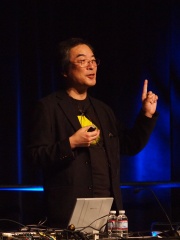
5. Toru Iwatani (b. 1955)
With an HPI of 62.91, Toru Iwatani is the 5th most famous Japanese Game Designer. His biography has been translated into 24 different languages.
Tōru Iwatani (岩谷 徹, Iwatani Tōru; born January 25, 1955) is a Japanese video game designer who spent much of his career working for Namco. He is best known as the creator of the arcade game Pac-Man (1980). In 2009, he was chosen by IGN as one of the top 100 game creators of all time.

6. Satoshi Tajiri (b. 1965)
With an HPI of 62.51, Satoshi Tajiri is the 6th most famous Japanese Game Designer. His biography has been translated into 40 different languages.
Satoshi Tajiri (Japanese: 田尻 智, Hepburn: Tajiri Satoshi; born August 28, 1965) is a Japanese video game designer and director who is the creator of the Pokémon franchise and the co-founder and president of video game developer Game Freak. A fan of arcade games in his youth, Tajiri wrote for and edited his own video gaming fanzine Game Freak with Ken Sugimori, before evolving it into a development company of the same name. Tajiri claims that the joining of two Game Boys via a link cable inspired him to create a game which embodied the collection and companionship of his childhood hobby, insect collecting. The game, which became Pokémon Red and Pokémon Green, took six years to complete and went on to spark a multibillion-dollar franchise which reinvigorated Nintendo's handheld gaming scene. Tajiri continued to work as director for the Pokémon series until the development of Pokémon Ruby and Sapphire, when he changed his role to executive producer, which he holds to this day. Tajiri has also worked for other Game Freak projects.

7. Shigesato Itoi (b. 1948)
With an HPI of 58.97, Shigesato Itoi is the 7th most famous Japanese Game Designer. His biography has been translated into 20 different languages.
Shigesato Itoi (糸井 重里, Itoi Shigesato; born November 10, 1948) is a Japanese copywriter, essayist, lyricist, game designer, and actor. Itoi is the editor-in-chief of his website and company Hobo Nikkan Itoi Shinbun ("Almost Daily Itoi Newspaper"). He is best known outside Japan for his work on Nintendo's Mother series of games, as well as his self-titled bass fishing video game.

8. Masayuki Uemura (1943 - 2021)
With an HPI of 58.94, Masayuki Uemura is the 8th most famous Japanese Game Designer. His biography has been translated into 21 different languages.
Masayuki Uemura (上村雅之, Uemura Masayuki; 20 June 1943 – 6 December 2021) was a Japanese engineer, video game producer, and professor. He was known for his work as an employee of Nintendo from 1971 to 2004, most notably for serving as a key factor in the development of the Family Computer. A former employee of Sharp Corporation, Uemura joined Nintendo in 1971 working with Gunpei Yokoi and Genyo Takeda on solar cell technology for the Laser Clay Shooting System arcade game. After becoming General Manager of Nintendo R&D2, Uemura served as the lead architect for the Family Computer and Super Famicom video game consoles. He retired from Nintendo in 2004 and became director for the Center for Game Studies at Ritsumeikan University.

9. Hironobu Sakaguchi (b. 1962)
With an HPI of 57.60, Hironobu Sakaguchi is the 9th most famous Japanese Game Designer. His biography has been translated into 29 different languages.
Hironobu Sakaguchi (坂口 博信, Sakaguchi Hironobu; born November 25, 1962) is a Japanese game designer, director, producer, and writer. Originally working for Square (later Square Enix) from 1983 to 2003, he departed the company and founded independent studio Mistwalker in 2004. He is known as the creator of the Final Fantasy franchise, in addition to other titles during his time at Square. At Mistwalker, he is known for creating the Blue Dragon and Terra Battle series among several standalone titles, moving away from home consoles and creating titles for mobile platforms. Originally intending to become a musician, he briefly studied electronics and programming, joining Square as a part-time employee, then later a full-time employee when Square became an independent company in 1986. He led the development of several titles before helping to create the original Final Fantasy, which proved highly successful and cemented his status within the company. Following the financial failure of Final Fantasy: The Spirits Within, his debut as a film director, Sakaguchi withdrew from Square's management and eventually resigned in 2003. He continued his game career through Mistwalker, first co-developing projects through external partners and then smaller in-studio mobile projects. Born in Hitachi, Ibaraki Prefecture, Sakaguchi now lives in Hawaii where one of Mistwalker's offices is based. He has also influenced the creation of several other Square Enix projects, such as Kingdom Hearts. Sakaguchi has received several industry awards.
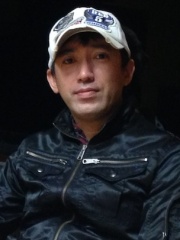
10. Shinji Mikami (b. 1965)
With an HPI of 57.52, Shinji Mikami is the 10th most famous Japanese Game Designer. Her biography has been translated into 25 different languages.
Shinji Mikami (三上 真司, Mikami Shinji; born August 11, 1965) is a Japanese video game designer, director, and producer. Starting his career at Capcom in 1990, he has worked on many of the company's most successful games. He directed the first installment of the Resident Evil series in 1996 and the first installment of the Dino Crisis series in 1999, both survival horror games. He returned to Resident Evil to direct the remake of the first game in 2002 and the survival horror third-person shooter Resident Evil 4 in 2005. In 2006, he directed his final Capcom game God Hand, a beat 'em up action game. Mikami founded PlatinumGames in 2006 and directed the third-person shooter Vanquish in 2010. That same year, he left the studio and founded a new studio Tango Gameworks and directed the survival horror game The Evil Within in 2014. He has also served the roles of producer and executive producer for many games. In 2023, he left the studio and founded a new studio KAMUY in 2024. In 2009, he was chosen by IGN as one of the top 100 game creators of all time.
People
Pantheon has 31 people classified as Japanese game designers born between 1941 and 1974. Of these 31, 28 (90.32%) of them are still alive today. The most famous living Japanese game designers include Shigeru Miyamoto, Hideo Kojima, and Toru Iwatani. The most famous deceased Japanese game designers include Satoru Iwata, Gunpei Yokoi, and Masayuki Uemura. As of April 2024, 5 new Japanese game designers have been added to Pantheon including Toshihiro Nagoshi, Keiichiro Toyama, and Tetsuya Takahashi.
Living Japanese Game Designers
Go to all RankingsShigeru Miyamoto
1952 - Present
HPI: 69.47
Hideo Kojima
1963 - Present
HPI: 66.39
Toru Iwatani
1955 - Present
HPI: 62.91
Satoshi Tajiri
1965 - Present
HPI: 62.51
Shigesato Itoi
1948 - Present
HPI: 58.97
Hironobu Sakaguchi
1962 - Present
HPI: 57.60
Shinji Mikami
1965 - Present
HPI: 57.52
Naoto Ohshima
1964 - Present
HPI: 56.88
Hidetaka Miyazaki
1974 - Present
HPI: 56.40
Masahiro Sakurai
1970 - Present
HPI: 55.45
Yoko Taro
1970 - Present
HPI: 55.38
Yu Suzuki
1958 - Present
HPI: 55.14
Deceased Japanese Game Designers
Go to all RankingsSatoru Iwata
1959 - 2015
HPI: 64.03
Gunpei Yokoi
1941 - 1997
HPI: 63.64
Masayuki Uemura
1943 - 2021
HPI: 58.94
Newly Added Japanese Game Designers (2025)
Go to all RankingsToshihiro Nagoshi
1965 - Present
HPI: 50.77
Keiichiro Toyama
1970 - Present
HPI: 48.65
Tetsuya Takahashi
1966 - Present
HPI: 47.71
Hajime Tabata
1971 - Present
HPI: 44.78
Kensuke Tanabe
1963 - Present
HPI: 42.95
Overlapping Lives
Which Game Designers were alive at the same time? This visualization shows the lifespans of the 3 most globally memorable Game Designers since 1700.

